This document discusses using art to practice making predictions by looking at pictures and thinking about what is happening and what may happen next based on clues. Students are asked to make predictions about what is occurring and will occur next after viewing several paintings. The document then prompts predicting outcomes from short stories by having students closely examine details and use prior knowledge.









